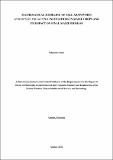| dc.description.abstract | Fall armyworm (FAW-Spodoptera frugiperda), a highly destructive and fast spreading agricul tural pest native to North and South America, poses a real threat to global food security. It
is estimated that intermittent FAW outbreaks could cause up to $US 13 billion per annum in
crop losses throughout sub-Saharan Africa. Considering this projected loss it is imperative that
various tools and techniques be utilized to infer on the various factors that affect FAW maize in teraction and in-turn affect the final maize biomass. Mathematical modeling has proved to be an
important tool that is capable of shedding light on the FAW-maize interaction dynamics. In this
study, three mathematical models were proposed to evaluate the impact of memory effects and
controls, seasonality and Integrated Pest Management strategy (farming awareness and larvae
predation) on FAW infestations in maize crops and on final maize biomass. Firstly, to evaluate
the impact of memory effects and control, a new dynamical system for FAW-maize biomass
interaction via Caputo fractional-order operator was proposed and analyzed. In the proposed
model, four equilibrium points which revealed the existence of a threshold parameter defined
by R0 were computed and analyzed. Further, it was observed that, R0, the average number of
newborns produced by one individual female moth during its life span was an integral compo nent for stability of the aforementioned model equilibria. Secondly, to evaluate the implications
of seasonality on FAW maize interaction and on the final maize biomass, a non-autonomous
mathematical model was proposed and analyzed. The analysis revealed that the model solution
was non-negative, unique, permanent and bounded admitting global asymptotic and continuous
periodic function. Further, the model was extended into an optimal control problem with the
aim of determining optimal pesticides and traditional methods that are capable of minimizing
FAW egg and larvae populations at minimum cost. Results from the study demonstrated that
a combination of pesticides use at low intensity with traditional methods at higher intensity
could eradicate FAW in a maize field in a period less than half the life span of the crop in the
field. Thirdly, to evaluate the impact of farming awareness campaigns and larvae predation,
a fractional-order model that incorporated farming awareness campaigns and larvae predation
was proposed and analysed. Overall, the study highlighted that, non-time dependent farming
awareness campaigns should be close to 100% all the time to eradicate the FAW. However,
when time-dependent farming awareness was implemented, it was observed that even less than
50% intensity level could lead to eradication of FAW. In all the proposed models, comprehen sive numerical simulations were carried out in MATLAB programming language to support the
analytical findings. In a nutshell, the results of this study showed that mathematical models can
be important tools to evaluate FAW and maize interaction dynamics. | en_US |

